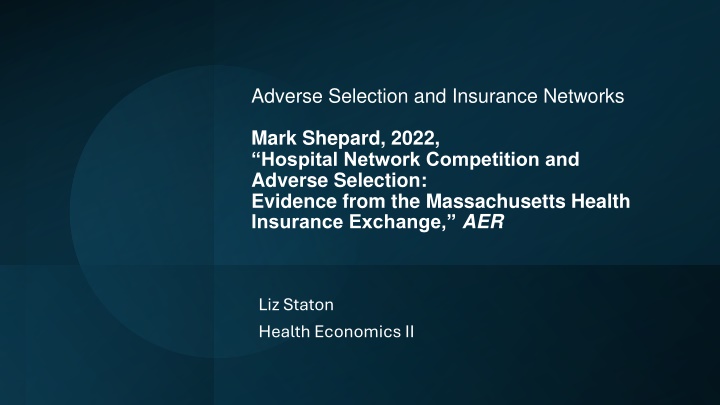
Hospital Network Competition and Adverse Selection: Evidence from Massachusetts
This study explores the impact of hospital network competition on adverse selection in the Massachusetts health insurance exchange. It highlights the incentives for insurers to exclude top-tier providers despite risk adjustment measures. The research delves into how patient preferences and switching patterns affect costs in the context of network changes.
Download Presentation

Please find below an Image/Link to download the presentation.
The content on the website is provided AS IS for your information and personal use only. It may not be sold, licensed, or shared on other websites without obtaining consent from the author. If you encounter any issues during the download, it is possible that the publisher has removed the file from their server.
You are allowed to download the files provided on this website for personal or commercial use, subject to the condition that they are used lawfully. All files are the property of their respective owners.
The content on the website is provided AS IS for your information and personal use only. It may not be sold, licensed, or shared on other websites without obtaining consent from the author.
E N D
Presentation Transcript
Adverse Selection and Insurance Networks Mark Shepard, 2022, Hospital Network Competition and Adverse Selection: Evidence from the Massachusetts Health Insurance Exchange, AER Liz Staton Health Economics II
Overview Research Question Research Question What is the role of selection when insurers compete on a key aspect of network quality: coverage of the top star hospitals in a market? Empirical Strategy Empirical Strategy Variation in pre-ACA insurance exchange coverage of Mass. top star hospital system Key findings Key findings Substantial selection incentives to exclude star providers that persist despite risk adjustment intended to offset adverse selection
Theoretical Framework How insurer j s profits change when it covers star hospital 2 models for costs: Limits of risk adjustment to account for cost heterogeneity
Set up of empirical analysis 2012 event: Network Health dropped the Partners hospitals and associated physicians, plus several less prestigious hospitals
Evidence of risk selection & roles of sickness and preferences Patients who value the excluded providers to switch plans to keep access to their preferred hospital or doctor. Because these enrollees have high risk-adjusted costs, this switching benefits Network Health via favorable selection Strong correlates of demand for Partners: Being sicker/medical risk accounts for 53% of switchers higher costs Preference measures (e.g., distance or provider loyalty)
Switching patterns & costs Partners patients are most likely to switch after 2012 coverage change, and those who live closest to a Partners hospital have a higher likelihood of switching than those who live further (Fig 2) Switchers have higher average costs, even after risk adjustment (Fig 3)
Decomposition analysis of switchers high costs Theorized Mechanisms 1. Unobserved medical risk (sickness) 2. People who demand star hospital coverage have higher costs because they use its expensive care (provider price factor)
Insurance demand for star hospitals Shepard estimates consumers willingness to pay for star hospital coverage with a multinomial logit plan choice model with subsidized premiums, network value, inertia of current enrollment, and plan dummy variables Enrollees are price sensitive but because premiums are low, the implied consumer demand elasticity is -1.48 less negative for higher income, sicker, and older enrollees, who also have higher utility of networks covering their desired providers. Implies higher willingness to pay for provider coverage Insurer cost model Analysis of the role of selection vs moral hazard incentives involved in 2012 network narrowing decision After further WTP and cost curve analysis of star hospital coverage, the basic finding that costs of star hospital coverage are larger costs of star hospital coverage are larger than consumers WTP appears robust than consumers WTP appears robust the basic finding that
Discussion questions Shepard identifies the policy dilemma of demand for star hospitals being driven by both sickness (warranting policies to ensure star hospital coverage) and preferences (based on which he says regulators might be comfortable letting coverage unravel ). What do you think about this policy dilemma as described? 1 Is there anything you think may have changed since the date range (2010-2013) of this analysis if this were to be replicated using more current data (assuming similar empirical example of selection on hospital network quality available)? 2
